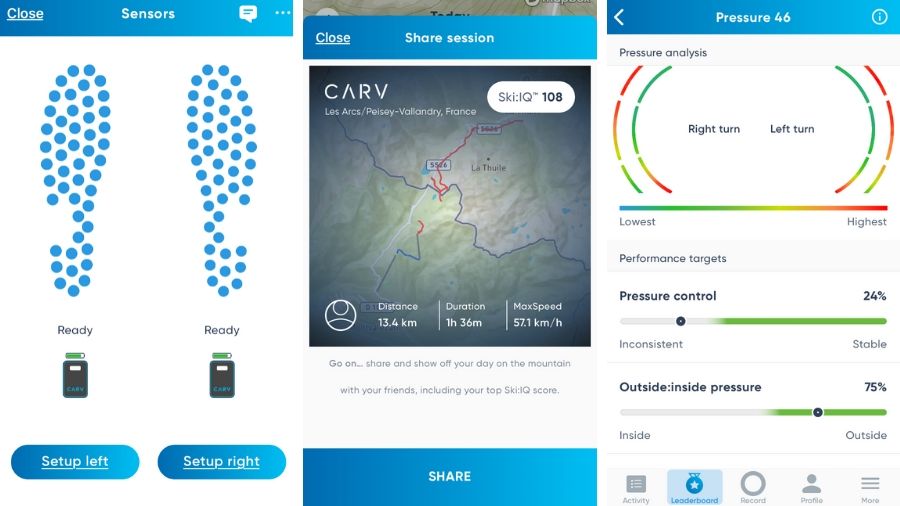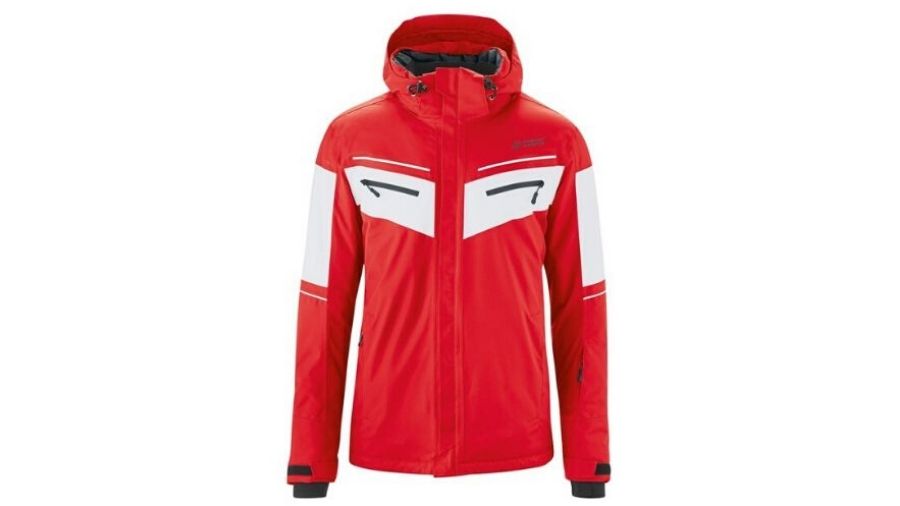The best skiing gadgets and gear 2021: have fun and stay safe on the slopes
From helmetphones to widescreen whiteouts

Skiers love gadgets. From constantly upgrading their skis and helmets to fetishising over the latest accessories, winter consistently brings a wave of gadgets aimed at those wanting to travel fast on snow. From the latest wide-angle ski goggles and a novel ‘helmetphone’ to a tech-friendly ski jackets and even a digital ski instructor, here’s what’s coming to a piste near you this winter.

SunGod Vanguards Ski Goggles
Reasons to buy
Reasons to avoid
Once an annoying must-have accessory for skiers that drastically cut down on peripheral vision, ski goggles have moved on a lot in recent years. At the apex of a new wave are the Vanguards SunGod ski goggles (US$144/UK£110, about AU$210), which are all about maximizing field of view in all kinds of conditions while protecting a skier’s eyes from snow, wind and harmful UV rays
During the ordering process online you can specify the color of the (super-slim) frame as well as the style of strap, and choose from eight different goggle lenses. Each is subtly different according to Visual Light Transmission (VLT) – the amount of light a lens allows to pass through – but the SunGod 4KO cylindrical dual-layer polycarbonate vacuum lenses all have one thing in common: they are huge.
Hardware-wise, the sheer size takes some getting used to, but the widescreen views of the mountain definitely don’t. Our only word of caution is to buy these first, then find a helmet that can comfortably take them (if your helmet is too small, your nose will get squashed!).

Carv Digital Ski Instructor
Reasons to buy
Reasons to avoid
How are your parallel turns? For most of us, ski trips go like this; arrive excited, realise how terrible you are at actually skiing, then enroll in an école de ski and take a few incredibly expensive lessons. Or you could just get your own wearable ski coach. A clever combo of well-placed sensors and a smartphone app, Carv ($390/£299, about AU$580) consists of inserts for each ski boot and two small battery packs.
They fit in any ski boots, no problems, and setting up only means waving your feet around a bit to tune the sensors. After that it’s all app-based, with a rather robotic AI called Samantha, Alex or Arthur monitoring your balance, edging, rotation and pressure and giving you real-time audio coaching. Each turn gets a pleasant ‘ding!’ or a comment like ‘center yourself’ or ‘your weight is too much on your inside ski’, as well as motivational nonsense like ‘you got this!’ and ‘go get ‘em tiger!’.
The only issue is that the feedback is delivered a few seconds after each turn, a delay that can get confusing. It’s also all a bit micro-level; you don’t get much feedback on a day's skiing aside from a ‘ski IQ’.
If you’re a beginner, the section on balance is especially useful, though the clueless should really head for a real life ski instructor. Carv is best for intermediate or advanced skiers – or those that think they are – who love data.
With so much data collecting going on – including complete mapping and stats for every run you do – Carv is undoubtedly incredible. It will find your weaknesses and help perfect your technique, but it’s best used sparingly to avoid it becoming a bit of a nag.

Maier Sports Podkoren Ski Jacket
Reasons to buy
Cheap ski jackets and salopettes are everywhere, but they just don’t last. As well as being just so warm soft and comfortable, the partly padded Podkoren ($275/£230, about AU$410) has some clever design motifs.
An earphone cable loop-through makes the inside pocket ideal for storing a phone if you want to ski to music, while two watertight chest pockets are ideal for taking valuables and anything else you need quick access to. The hood zips on and off, and cleverly attaches to the jacket’s lapels with Velcro, while the cuffs have thumbholes for maximum warmth.
However, it’s the Podkoren’s waterproof, windproof and breathable mTEX 10.000 membrane that wins the day in cold conditions. The Podkoren is available in red, blue, black and gray.

Livall RS1 Smart Helmetphone
Reasons to buy
Reasons to avoid
Keeping in touch with others can be tricky when you're skiing. Until recently, old fashion walkie-talkies were all the rage on the slopes, but in recent years a lot of so-called helmetphones have appeared.
The Livall RS1 ($196/£150, about AU$300) is equipped with stereo headphones, and pairs with your smartphone. On a basic level, it acts as a Bluetooth headset for both listening to music – albeit in pretty basic, bass-free quality – and for receiving calls just by touching (with gloved hand) a large button on the right hand side of the helmet. That works pretty well, and it’s handy if you are at the bottom of the slope wondering if your ski buddy has taken a fall… or is way late for lunch.
There is a second ‘walkie talkie’ function that allows short messages to be sent between two identical helmets (basically by setting-up a group chat session), but Apple’s iOS13 update has banned background recording by apps, so that’s now a no-go on the slopes.
However, it’s that ‘hands-free’ function that impresses most, though streaming music and taking/making phone calls obviously depends on having a good phone signal in the ski resort you’re in.

Garmin Fenix 6
Reasons to buy
Reasons to avoid
Garmin’s flagship GPS multisport smartwatch lineup has a surprise in it for skiers. Inside all three models – the Fenix 6, Fenix 6X and Fenix 6X Pro Solar (from $800/£600, about AU$1,200) – are ski maps for over 2,000 ski resorts worldwide complete with the names of individual runs.
It’s able to track the speed, distance and vertical drop data for each ski run thanks to its three-axis compass, gyroscope and barometric altimeter. It’s also got on-device music storage of up to 2,000 songs, and as well as skiing suits just about every outdoor activity you can think of. Get the Fenix 6X Pro Solar edition and you even get solar charging, too. Better hope for a bluebird day…

Phoozy Apollo II BlackOut Plus
Reasons to buy
You might think you need a waterproof phone case to go skiing. What you actually need is something to keep your phone warm because – as all skiers and snowboarders know – freezing conditions can massively reduce the battery life of a fully-charged phone. Cue Phoozy’s Apollo II BlackOut Plus (US$30/UK£33, about AU$60), which is designed for an inner jacket pocket or a pocket on salopettes.
It uses thermal tech much like that found in NASA’s space suits to protect astronauts in the extreme conditions in outer space. It can extend the battery life of a phone by three times in freezing conditions and, as a bonus, gives your phone military-grade shock protection from drops of up to six feet.
If you want to keep a phone on all day – whether for playing music, keeping in contact with friends on the slopes, or in case of an emergency – the Apollo II BlackOut Plus is a good bet. It comes in silver or gold, and in Slim, Plus and XL sizes to cater for all phones.

Mammut Flip Removable Airbag 3.0
Reasons to buy
Reasons to avoid
Are you heading off-piste? If you intend to spend time in backcountry areas away from groomed pistes, your enemy instantly changes from snowboarders speeding into you – ‘bombers’ – to snow-slides and avalanches. These mounds of snow, ice and debris should scare you into getting some proper avalanche training, but meanwhile the 22-liter Mammut Flip Removable Airbag 3.0 backpack (US$530/UK£460, about AU$780) – enough for storing a snack, a drink and an extra warm layer – stores a super-light airbag system 3.0 in a special front pocket.
Compatible with hydration packs like Camelbak, the Flip you to tug on a cord to inflate the airbag and so give yourself some breathing space. It’s also got space for avalanche safety equipment and a separate radio pocket that holds a communication device.
- The best running watches and best running headphones available today
Sign up for breaking news, reviews, opinion, top tech deals, and more.

Jamie is a freelance tech, travel and space journalist based in the UK. He’s been writing regularly for Techradar since it was launched in 2008 and also writes regularly for Forbes, The Telegraph, the South China Morning Post, Sky & Telescope and the Sky At Night magazine as well as other Future titles T3, Digital Camera World, All About Space and Space.com. He also edits two of his own websites, TravGear.com and WhenIsTheNextEclipse.com that reflect his obsession with travel gear and solar eclipse travel. He is the author of A Stargazing Program For Beginners (Springer, 2015),